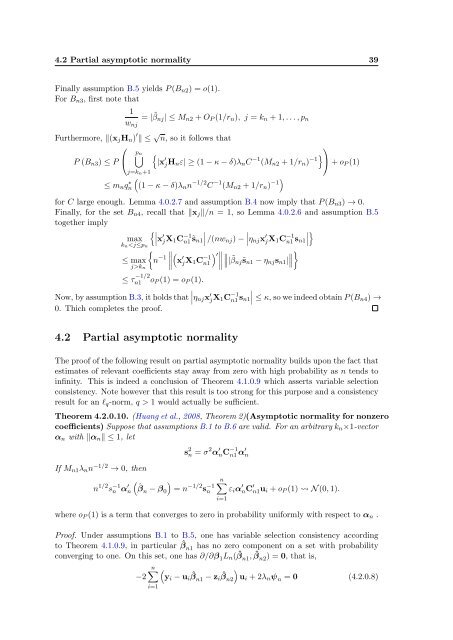Subsampling estimates of the Lasso distribution.
Subsampling estimates of the Lasso distribution.
Subsampling estimates of the Lasso distribution.
Create successful ePaper yourself
Turn your PDF publications into a flip-book with our unique Google optimized e-Paper software.
4.2 Partial asymptotic normality 39<br />
Finally assumption B.5 yields P (B n2 ) = o(1).<br />
For B n3 , first note that<br />
1<br />
w nj<br />
= | ˜β nj | ≤ M n2 + O P (1/r n ), j = k n + 1, . . . , p n<br />
Fur<strong>the</strong>rmore, ‖(x j H n ) ′ ‖ ≤ √ n, so it follows that<br />
⎛<br />
⋃p n {<br />
P (B n3 ) ≤ P ⎝ |x ′ jH n ε| ≥ (1 − κ − δ)λ n C −1 (M n2 + 1/r n ) −1}⎞ ⎠ + o P (1)<br />
≤ m n q ∗ n<br />
j=k n+1<br />
((1 − κ − δ)λ n n −1/2 C −1 (M n2 + 1/r n ) −1)<br />
for C large enough. Lemma 4.0.2.7 and assumption B.4 now imply that P (B n3 ) → 0.<br />
Finally, for <strong>the</strong> set B n4 , recall that ‖x j ‖/n = 1, so Lemma 4.0.2.6 and assumption B.5<br />
toge<strong>the</strong>r imply<br />
{∣ ∣∣x ′<br />
max j X 1 C −1<br />
k nk n<br />
≤ τ −1/2<br />
n1 o P (1) = o P (1).<br />
∣<br />
Now, by assumption B.3, it holds that ∣η nj x ′ j X 1C −1<br />
0. Thich completes <strong>the</strong> pro<strong>of</strong>.<br />
∣<br />
∣ /(nw nj ) − ∣η nj x ′ jX 1 C −1<br />
) ∥ ′ ∥∥∥ ∥ }<br />
∥∥| n1 ˜βnj˜s n1 − η nj s n1 | ∥<br />
n1 s ∣<br />
n1<br />
}<br />
n1 s n1∣<br />
∣ ≤ κ, so we indeed obtain P (B n4 ) →<br />
4.2 Partial asymptotic normality<br />
The pro<strong>of</strong> <strong>of</strong> <strong>the</strong> following result on partial asymptotic normality builds upon <strong>the</strong> fact that<br />
<strong>estimates</strong> <strong>of</strong> relevant coefficients stay away from zero with high probability as n tends to<br />
infinity. This is indeed a conclusion <strong>of</strong> Theorem 4.1.0.9 which asserts variable selection<br />
consistency. Note however that this result is too strong for this purpose and a consistency<br />
result for an l q -norm, q > 1 would actually be sufficient.<br />
Theorem 4.2.0.10. (Huang et al., 2008, Theorem 2)(Asymptotic normality for nonzero<br />
coefficients) Suppose that assumptions B.1 to B.6 are valid. For an arbitrary k n ×1-vector<br />
α n with ‖α n ‖ ≤ 1, let<br />
If M n1 λ n n −1/2 → 0, <strong>the</strong>n<br />
)<br />
n 1/2 s −1<br />
n α ′ n<br />
(ˆβn − β 0 = n −1/2 s −1<br />
n<br />
s 2 n = σ 2 α ′ nC −1<br />
n1 α′ n<br />
n∑<br />
ε i α ′ nC ′ n1u i + o P (1) N (0, 1).<br />
i=1<br />
where o P (1) is a term that converges to zero in probability uniformly with respect to α n .<br />
Pro<strong>of</strong>. Under assumptions B.1 to B.5, one has variable selection consistency according<br />
to Theorem 4.1.0.9, in particular ˆβ n1 has no zero component on a set with probability<br />
converging to one. On this set, one has ∂/∂β 1 L n ( ˆβ n1 , ˆβ n2 ) = 0, that is,<br />
−2<br />
n∑<br />
i=1<br />
(y i − u i ˆβn1 − z i ˆβn2<br />
)<br />
u i + 2λ n ψ n = 0 (4.2.0.8)
















